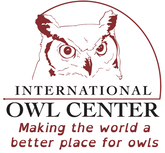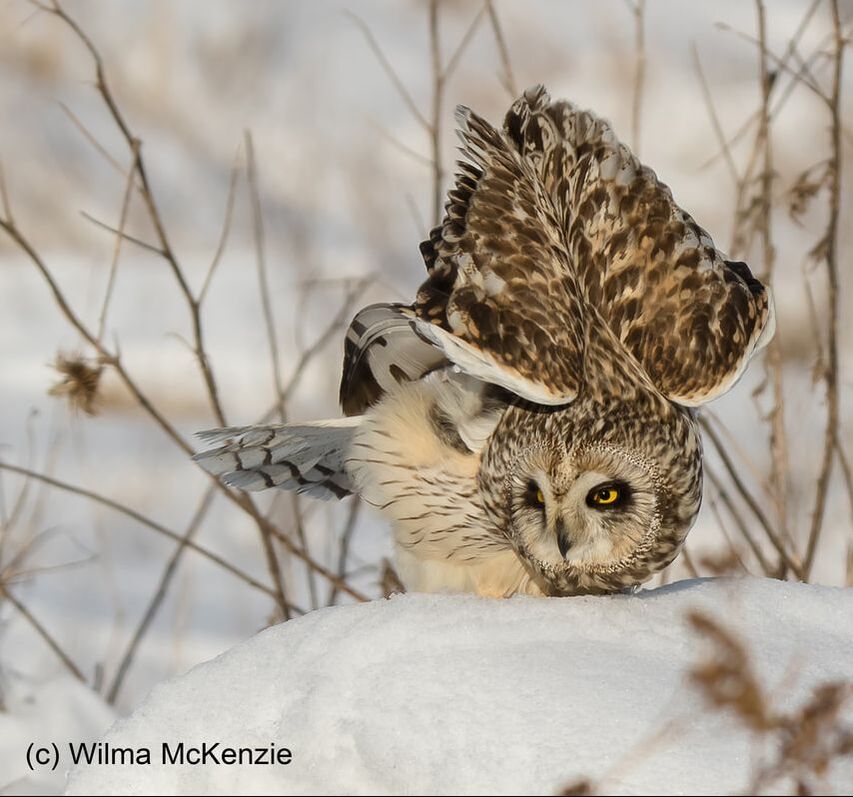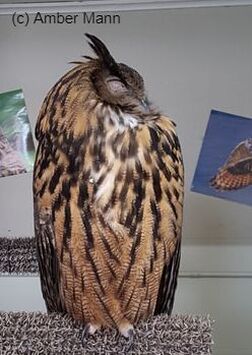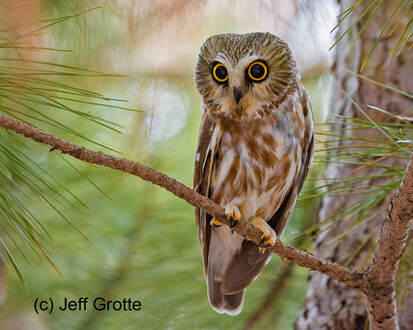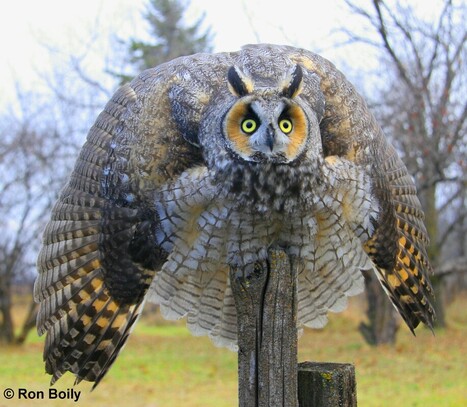How to respectfully photograph and observe owls
Every owl is an individual and every situation is unique. Just look at the photo above by Lance Retterer: these Great Horned Owls at a rehab center are all in the same situation, but with wide variation in the degree of reaction. You photograph, watch, or listen to owls because you like them, so odds are you don't want to disturb the owls. There are no one-size-fits-all rules to avoid disturbing owls, so if you learn to interpret owl behavior you can let the owl tell you if your behavior is acceptable to them.
***Remember that the best way to find owls is to spend a lot of time outdoors.***
***Remember that the best way to find owls is to spend a lot of time outdoors.***
Relaxed owls
The owls in this section are relaxed. Signs of relaxation are explained next to each photo.
|
Ear tufts lowered but not flat, head feathers not contracted or expanded, upper eyelids are slightly lowered
This individual Great Horned Owl has repeatedly nested in a very urban area. She is very habituated to humans so photographers can approach quite closely without bothering her. Below is a photo of the nest and surrounding area. |
Stressed owls
The owls in this section are stressed. Signs of stress are explained next to each photo.
|
|
The "Go-Away" Blink
Some owls will rapidly and/or very deliberately blink their eyes, often in conjunction with wide eyes and small pupils. This is functionally showing you they want you to back off or leave. This captive Eastern Screech-Owl is doing a lower-level version of this "go-away" blink. |
|
Concealment posture: head and body plumage compressed, ear tufts straight up, eyes reduced to slits
Both feet are on the perch, which will always be the case in a stressed owl, but is not necessarily a sign of stress. Note that this Eastern Screech-Owl is not looking at the photographer. It was looking at a dog in the dog park where it was roosting. Owls have a natural fear of dogs. |
|
|
Looking to fly away
When an owl rapidly looks around, bobs its head, squats and puts its wings slightly out it is preparing to fly away and is looking for a safe place to go. In this video Ruby the Great Horned Owl is very nervous about some gravel being raked as her aviary is cleaned and is looking for an escape. |
|
Head lowered, wings partially fanned out, rocking back and forth
Barn Owls will lower their bill almost to the ground, not look at you, and shake their head "no" back and forth. This display is referred to as "toe dusting". It is an extreme threat and may precede an attack. This individual was a wild Barn Owl in captivity while being treated for West Nile Virus. |
|
Defense display
This captive Long-eared Owl saw some Halloween decorations that scared it. Many owls, especially medium to large owls, will fan out their wings and puff up enormously when scared. This display is usually accompanied by hissing and rapidly snapping the bill shut. This is a sign of extreme fear and is generally only given when an owl is grounded and approached closely by a human or predator. Adults would normally fly away, but injured birds and juveniles that can't fly well are most likely to give this display. |

Daytime flying
Most (not all) owl species are nocturnal or crepuscular and try to conceal themselves during the day to avoid being mobbed by other birds. During the winter Snowy Owls prefer to roost during the day, often on the ground, and generally do not choose to fly until dusk unless disturbed. Although many references state that Snowy Owls are diurnal, they are crepuscular or nocturnal on their wintering grounds. They do occasionally fly during the day without being stressed, as in the case of this photo.
Most (not all) owl species are nocturnal or crepuscular and try to conceal themselves during the day to avoid being mobbed by other birds. During the winter Snowy Owls prefer to roost during the day, often on the ground, and generally do not choose to fly until dusk unless disturbed. Although many references state that Snowy Owls are diurnal, they are crepuscular or nocturnal on their wintering grounds. They do occasionally fly during the day without being stressed, as in the case of this photo.
|
|
Panting
This captive Great Horned Owl is panting because she is warm, but owls also pant when stressed, since stress can cause overheating. Be aware that owls under extreme stress generally will not pant, since it shows vulnerability. Wild owls will likely only pant due to stress if they are in a situation where they cannot escape from humans or other cause of their stress. |
How to behave around owls
|
Give them space.
The majority of owls don't like being around people, although some in urban areas become habituated to humans and tolerate fairly close approach. Use cameras with long lenses. Don't try to get a good photo with a cell phone since you will very likely have to get close enough to scare the owl. Err on the side of caution, give them space, and learn to read their body language. |
|
Let them find their own food.
Feeding owls is a cumulative problem. One person offering a live mouse once or twice won't make a difference (as long as they are not baiting the owl across a road), but there is no way you can know you are the only person offering the owl food as owls can and do move and social media can bring an influx of observers/photographres in a big hurry. A series of people baiting the same owl can cause owls to associate humans with food. Cumulative impacts are a very real thing due to birding websites and social media posts about owl locations. Assume every owl will encounter many observers/photographers and let them find their own food. |
|
|
This video shows a wild young Snowy Owl begging for food from people, taken by Deb Chryssanthis in Minnesota. This behavior was very likely developed by repeated baiting.
|
|
Avoid using artificial lights after dark.
Although there are no published studies, simple experiments by Northern Saw-whet Owl banders show that owls banded at night will fly away faster and without issues if kept in the dark for five minutes before release, as opposed to owls exposed to lights before release. This indicates the night vision of owls is temporarily affected by lights. Our own experiments show that owls can see red lights and red lasers also, but not infrared lights. |
|
Leave your dog at home.
Owls have a natural fear of dogs. While some urban owls that are highly habituated to human activity may tolerate dogs, assume the vast majority of owls will be stressed by the presence of a dog. If you are observing human habituated owls, observe the owl's behavior to see if dogs stress the owl. |
|
Use your car as a blind when it's safe to do so.
Owls are often more tolerant of humans in vehicles than outside of vehicles. Be sure to park on the CORRECT side of the road to avoid stressing other drivers (photograph/observe from the passenger seat), and turn your engine off. Hunting owls will thank you for the quiet so they can hear their prey better! |
|
|
Leave your drone at home.
Owls and other raptors often perceive a drone as a threat in their airspace, especially around a nest. This can be highly stressful and may provoke owls to attack the drone, as the pair of Barred Owls does in this video. Owls and other raptors can be injured by the blades of some drones when they attack them (and the owls may also damage the drone.) permission to use this video granted by The Drone King |
|
Think before you use playback.
Owls often call back or come in to playback of calls of their species. This method may be used by researchers, but doing this purely for recreation needs to be carefully considered. It is illegal in national parks in the USA due to the extreme disturbance likely due to the high number of visitors. We strongly encourage people to avoid using playback in any public area to avoid repeated disturbance, significantly limit playback on private property, and never use it for rare species like Spotted Owls. |

Think carefully before you share the location of an owl.
Nesting owls are easy to photograph because the birds are tied to their location once eggs are laid. Some northern owls also become habitual about their wintering grounds and are easy to see. It is all too easy for these birds to be mobbed by photographers and other observers if locations are shared, especially on social media and birding websites. Although there is absolutely value in showing an owl to people who have never had the pleasure of seeing a wild owl, think very carefully about if the owl you have found is at risk of being loved so much it is functionally harassed by the public. A good practice is often to report the owl's location only at the county level or after the owl is no longer in the area.
Nesting owls are easy to photograph because the birds are tied to their location once eggs are laid. Some northern owls also become habitual about their wintering grounds and are easy to see. It is all too easy for these birds to be mobbed by photographers and other observers if locations are shared, especially on social media and birding websites. Although there is absolutely value in showing an owl to people who have never had the pleasure of seeing a wild owl, think very carefully about if the owl you have found is at risk of being loved so much it is functionally harassed by the public. A good practice is often to report the owl's location only at the county level or after the owl is no longer in the area.
|
Limit your time with the owl.
Give wild owls plenty of privacy by keeping your visits short. Most species are trying to sleep a big part of the day and although they are normally awake for short periods throughout the day, they most likely aren't sleeping with you there. They are also trying to avoid being discovered by other bird species that will mob them and your presence, especially if you flush one, increases their chances of being mobbed. Even habituated owls are going to be more relaxed when humans aren't around. Take into account how much time others are spending with the owl also, as the impact is cumulative. |
|
Leave branches on trees.
Owls have chosen their roost and nest locations in part because of the shelter from the weather and camouflage the location offers. Removing branches so you can get an unobstructed view of the owl is counter to the owl's wishes to remain hidden. Owls need to conceal themselves to avoid being mobbed by smaller birds, being eaten by larger hawks and owls, and feeling threatened by dogs, humans and other perceived threats. Keep in mind that if you don't own the tree, it may violate laws or rules for you to remove branches. This guidance is especially important for Northern Saw-whet Owls that habitually roost in the same spot most days in the winter and are small enough to be a meal for many other animals. |
|
Be respectful of other people.
Share your binoculars, spotting scope, or camera view with others who may happen by without viewing optics, and share information with them. You may observe others who are not behaving ethically around owls. They may or may not be aware of how their behavior is impacting owls. Respectfully point out how their behavior is affecting the owl and model good behavior yourself. If they choose not to heed your advice, you may choose to tolerate their behavior, leave the situation, or report it to the authorities if it is illegal. Verbally assaulting people who are not behaving well or photographing them to smear them on social media will not improve the situation or help owls. Treat others as you would like to be treated. |
Thank you for enjoying owls respectfully!
|
Links - Privacy policy
International Owl Center
126 E Cedar St. Houston, MN 55943 (507) 896-OWLS (6957) info@InternationalOwlCenter.org 501(c)(3) organization EIN #45-5503365 |
|
|
